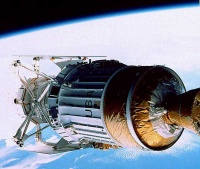Magellan
From The Space Library
 | |
| Organization | Centre National d'Etudes Spatiales (France),NASA-Office of Space Science Applications (United States) |
|---|---|
| Mission type | Planetary Science |
| Launch date | May 4, 1989 |
| Launch vehicle | STS-30 |
| Carrier rocket | Space Shuttle-Inertial Upper Stage |
| Launch site | Cape Canaveral, United States |
| COSPAR ID | 1989-033B |
| Mass | 1035.0 kg |
| Experiments | Here |
| Alternate Names | Venus Radar Mapper, 19969 |
| Nominal Power | 1029.0W |
| Additional Information | Here |
| PDMP Information | Here |
| Telecommunications Information | Here |
| Data Collection | Here |
Magellan was a unique mission, the first dedicated U.S. mission to study in detail, using Synthetic Aperture Radar (SAR), the surface of Venus. Because Magellan was intended to be a low cost mission, major components of the spacecraft were obtained from flight spares from other programs including Galileo, Viking, Voyager, Mariner, Skylab, Ulysses, and even the shuttle. Designed as a follow-up to the mapping portion of the Pioneer Venus mission, Magellan's purpose was to: (1) obtain near-global radar images of Venus' surface with a resolution equivalent to optical imaging of 1 km per line pair; (2) obtain a near-global topographic map with 50 km spatial and 100 m vertical resolution; (3) obtain near-global gravity field data with 700 km resolution and 2--3 milligals (1 gal = 1 cm/s**2) accuracy; and, (4) develop an understanding of the geological structure of the planet, including its density distribution and dynamics. Spacecraft and Subsystems. The spacecraft consisted primarily of a large (3.7 m) high-gain antenna dish which served the dual purpose of communications and science instrument for the SAR. The spacecraft was about 6.4 m long and, with the solar panels extended, about 9.2 m across. Behind the dish was a rectangular section containing the radar sensor electronics, reaction wheels, and batteries. Behind this section lay a decahedral bus, which included the solar panel array, star scanner, a medium-gain antenna, the on-board computer and two tape recorders. Behind the bus lay the propulsion module. The two 5.8 m solar panels were used for powering the spacecraft and charging the spacecraft's nickel-cadmium batteries. These batteries provided the 28 V of power needed during solar occultation to allow normal spacecraft operations. Pointing control was maintained through the use of three electrically powered, orthogonal reaction wheels. Large scale orbital corrections, both in transit to Venus as well as after orbital insertions, was accomplished through the use of a monopropellant (hydrazine) thruster system. The thrusters were also used to permit desaturation of the momentum wheels. The coherent X- and S-band radio subsystem was used for communications as well as by the gravity field experiment. Mission Profile Magellan reached Venus and went into orbit on 10 August 1990. The initial phase of the mission (Cycle 1) began shortly after orbital insertion about Venus and lasted for eight months (15 Sept. 1990--15 May 1991). During this cycle, Magellan collected radar images of about 84% of the planet's surface. Cycle 2 lasted from the end of cycle 1 until 15 Jan. 1992, during which the spacecraft obtained images of the southern polar region and filled numerous gaps left in cycle 1 information. Cycle 3 began on 24 Jan. 1992 and lasted until 15 Sept. 1992, during which the remaining gaps from cycle 1 were filled in as well as providing data which, in combination with earlier data, could be used to produce stereo images of the surface. Cycle 4 lasted from 15 Sept. 1992 to May 1993 and consisted of gravity data acquisition from the elliptical orbit. An aerobraking maneuver, in which Magellan was dipped into the Venus atmosphere to shed orbital energy and bring the spacecraft into a more circular orbit, was performed from 24 May until 02 August 1993. At the end of aerobraking, the orbit had a periapsis of 180 km, an apoapsis of 540 km, and a period of 94 minutes. Cycle 5 was used to acquire gravity from this orbit from 03 August 1993 until 29 August 1994, giving high-resolution gravity data for about 95% of the planet. In September, 1994 the Windmill experiment took place, in which the solar panels were tilted at an angle so that atmospheric drag put a torque on the craft, which could be measured to give information about the atmospheric density at different altitudes. Magellan began its final descent into the Venus atmosphere on 11 October 1994. On 12 October radio contact was lost, and the spacecraft presumably burned up in the atmosphere on 13 or 14 October 1994. By the end of the mission, over 99% of the planet's surface had been mapped with a resolution ten times better than that obtained by the earlier Soviet Venera 15 and 16 missions. The total cost of the mission through 29 October 1991 was $551 million, consisting of $287 million for the spacecraft, $120 million for the radar system, $49 million for launch and operations through the first 30 days, and $95 million for mission operations and data analysis. The approximate additional cost of operations and analysis through the end of the mission (29 October 1991 to 12 October 1994) was $130 million, bringing the overall cost to roughly $680 million.
